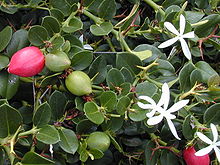- Carissa macrocarpa
-
Natal Plum 
Scientific classification Kingdom: Plantae (unranked): Angiosperms (unranked): Eudicots (unranked): Asterids Order: Gentianales Family: Apocynaceae Genus: Carissa Species: C. macrocarpa Binomial name Carissa macrocarpa
(Eckl.) A.DC.Synonyms Carissa grandiflora (E.Mey.) A.DC.
Carissa macrocarpa (Natal Plum), is a shrub native to South Africa, where it is commonly called the Large Num-Num. In Zulu, as well as in the Bantu tribes of Uganda, it is called amatungulu. In Afrikaans the fruit is called Noem-Noem.
C. macrocarpa deals well with salt-laden winds, making it a good choice for coastal areas. It is commonly found in the coastal bush of the Eastern Cape and Natal.[1] It produces shiny, deep green leaves and snowy white flowers whose perfumed scent intensifies at night. Like other Carissa species, C. macrocarpa is a spiny, evergreen shrub containing latex. They bloom for months at a time. The ornamental plump, round, crimson fruit appears in summer and fall at the same time as the blooms. In moderate, coastal areas the fruits appear through the year. The fruit can be eaten out of hand or made into pies, jams, jellies, and sauces.[1] Some claim that other than the fruit, the plant is poisonous.[2]
It appears in the South African National tree list as number 640.3.
A traditional food plant in Africa, this little-known fruit has potential to improve nutrition, boost food security, foster rural development and support sustainable landcare.[3]
Contents
Distribution
Carissa macrocarpa grows mainly in coastal areas in South Africa. It can be found on sand dunes and on the edges of coastal forests in Eastern Cape Province northwards from Natal to Mozambique. Today the plant is also growing commonly in southern Florida and is cultivated in southern California. [3]
Horticultural aspects
Propagation
Carissa macrocarpa is quite easy to grow. Its seeds germinate 2 to 4 weeks after sowing. The development of the seedlings is very slow at first. Plants cultivated from seeds are bearing fruits within the first 2 years. A vegetative propagation is possible and preferred. The most efficient method consists of notching young branchlets by cutting them halfway through. Then they are bent downwards and allowed to hang limply. After the young branchlets have built a callus, in approximately 2 months, the cutting has to be removed from the parent and planted in sand under moderate shade. Roots form within one month. Carissa macrocarpa will produce fruits within the first 2 years applying this reproduction method. [3]
Fertilizing
The maintenance of Carissa macrocarpa is simple. The plant needs a standard, balanced fertilizer (equal amount of N, P, K) for successful fruit production. [3]
Pollination
In the homeland of Carissa macrocarpa night-flying insects pollinates the big white flowers. Out of its origin area unfruitfulness has been attributed to inadequate pollination. However, hand pollination is possible and in future poor pollination could be avoided by cultivation of floral structures that are highly favourable for self-fertilization. [3]
Orchard design
Narrow hedges are recommended as orchard design for Carissa macrocarpa due to its prickles. Like this the access to the fruits which are growing on the top of the bush is much simpler. Pruning the plant is beneficial because it induces the development of more fruiting tips. Beyond cutting, little pruning work has to be done to restrain the bush from massive growth. This results in an increasing amount of fruits per plant. [3]
Harvesting
With a minimal yield of 3 tons per hectare under commercial production in South Africa, the productivity is considered as high. The main fruit production is in summer with slightly varying ripening times. So each fruit must be picked when it is ripe. Under good growing conditions the plant also produces many fruits during the off-season. During the harvest attention must be paid to the ripe fruits’ skin as it can be easily bruised and is highly perishable. [3]
Cultivars for crop-production
Horticultural Scientists in South Africa and the USA (Florida and California) have selected and named several Carissa types which tend to produce fruits more reliably. The fruits are larger, have a good texture and contain less seeds. In California they selected Fancy (many large fruits with few seeds), Torrey Pines (good crop-production and abundant pollen), Frank (good pollen supplier but low yield), Chelsey and Serena. In Florida Gifford is one of the best fruit bearers. In Africa C. haematocarpa is defined suitable for drier areas and C. bispinosa for higher altitudes. [3]
Environmental requirements
Carissa macrocarpa requires warm, moist subtropical climate. It tolerates different exposures as full sun and fairly heavy shade. As a coastal plant it can deal very well with salty ocean spray..
Factor Description Rainfall Up to 1000 mm/a Drought Drought-resistant and no watering requirements during summer rainfall areas Altitude 1000 m a.s.l. (Swaziland); likely up to 1500 m. Cold Cold-tolerant to -5°C; young plants needs protection Warmth Up to 32°C in the shade (Pretoria); best growth in full sun exposure Soil Any (limestone, heavy clay, sand) if it drains well Salinity Salt-tolerant (5000 ppm) References
- ^ a b Sparrow, Jacqueline and Gil Hanly. (2002), Subtropical Plants: A Practical Gardening Guide, Portland, OR: Timber Press, Inc.
- ^ Floridata page for Carissa macrocarpa
- ^ a b c d e f g h i National Research Council (2008-01-25). "Carissa". Lost Crops of Africa: Volume III: Fruits. Lost Crops of Africa. 3. National Academies Press. ISBN 978-0-309-10596-5. http://books.nap.edu/openbook.php?record_id=11879&page=76. Retrieved 2008-07-15.
External links
- Desert-Tropicals.com
- "Carissa macrocarpa". Plantz Afrika. http://www.plantzafrica.com/plantcd/carismac.htm. Retrieved 2010-02-12.
- "Carissa macrocarpa". Ecocrop FAO. http://ecocrop.fao.org/ecocrop/srv/en/cropView?id=4229. Retrieved 2010-02-12.

This Apocynaceae article is a stub. You can help Wikipedia by expanding it.

